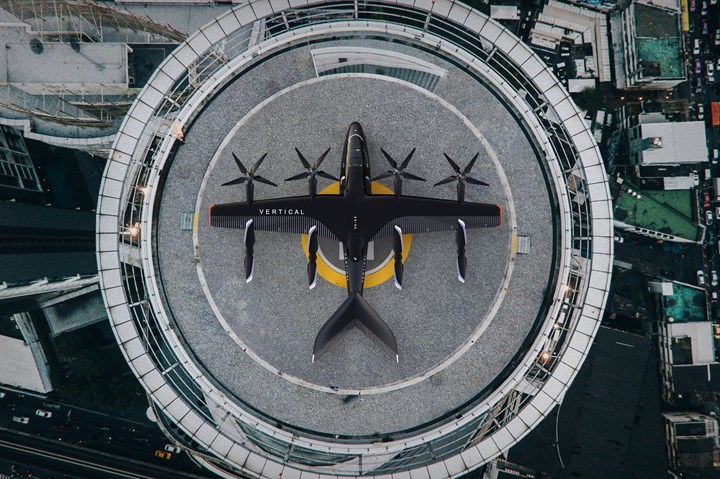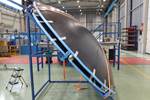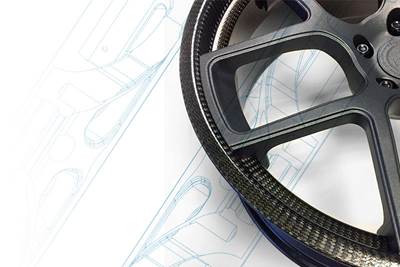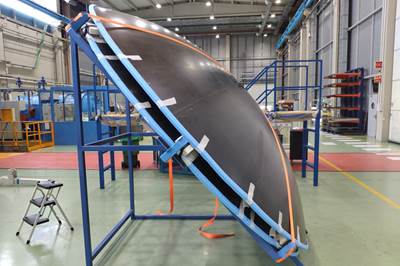Leonardo, Vertical Aerospace to jointly develop VX4 eVTOL carbon fiber fuselage
Leonardo lends its composite aerostructures expertise, honed on numerous civil and defense aerospace programs, for initial six certification aircraft.

Photo Credit: Vertical Aerospace
(Bristol, U.K.) an aerospace and technology company pioneering zero-emissions aviation, has agreed to a joint development program with (Rome, Italy) for the design, testing, manufacture and supply of the carbon fiber composite fuselage for Vertical’s electric aircraft.
The VX4 is a near-silent, entirely electric, piloted aircraft that is expected to have a range of more than 100 miles and to reach top speeds of up to 200 miles per hour. With a four-passenger capacity, Vertical says the zero-operating emissions VX4 will also have a low cost-per-passenger mile, similar to that of a taxi.
Vertical and Leonardo will work together on optimizing lightweight composite structures, modular design, systems installation and structural testing for the co-development of the aircraft’s fuselage. According to Vertical this is currently in place for at least six certification aircraft, up to the successful certification of the VX4.
The agreement has also stated the potential to scale fuselage production to 2,000 aircraft per year to meet Vertical’s existing order book demand. Vertical has what it believes is the largest conditional pre-order book (by value) in the electric vertical takeoff and landing (eVTOL) industry, with up to 1,350 aircraft worth $5.4 billion from American Airlines, Avolon, Bristow and Iberojet, including pre-order options from Virgin Atlantic and Marubeni, and through Avolon’s JAL and Gol airline placements (see “Vertical Aerospace secures funding for zero-emissions eVTOL aircraft”).
Leonardo has long-established expertise in composite aerostructures development and manufacturing on civil and defense programs. The aerospace firm also has a close relationship with Vertical’s strategic composite materials supplier, Solvay (Alpharetta, Ga., U.S.). Vertical and Solvay are jointly developing advanced materials and manufacturing technologies that will enable high-volume manufacture of the VX4.
“Leonardo, as partner to the world’s leading commercial aircraft manufacturers, specializes in the production and assembly of major structural composite and metallic components for commercial aircraft,” emphasizes Giancarlo Schisano, managing director of Leonardo’s Aerostructures Division. “Leonardo strives to bring new technologies, materials and processes into our established practices in our production sites. This will be the case at our Grottaglie plant in southern Italy, where we will focus our VX4 activities; the plant is one of the most advanced facilities in Europe to produce composite aerostructures.”
Moreover, the continuous development and integration of cutting-edge solutions across all domains, such as advanced air mobility (AAM), is also a key element of Leonardo’s BeTomorrow2030 Strategic Plan.
Vertical’s partnership with Leonardo builds on an ecosystem of partners, including Rolls-Royce (London, U.K.), Honeywell Aerospace (Los Angeles, Calif., U.S.), Solvay, GKN Aerospace (Redditch, U.K., see “Vertical Aerospace partners with GKN Aerospace on wing structure for VA-X4 eVTOL”) and Microsoft (Redmont, Wash., U.S.). Vertical continues to grow its team of experienced engineers and aviation executives and expects to begin the VX4’s test flight program later in 2022.
“Vertical is pioneering electric aviation and is on a mission to transform the way people travel. I have been impressed by Leonardo’s highly innovative and industry-leading technical and manufacturing capabilities and our partnership has got off to a flying start,” adds Michael Cervenka, president of Vertical Aerospace. “I’m thrilled that Leonardo will be joining us in this journey. We have a market-leading pre-order book for our VX4, and this partnership will ensure that we can scale the program to meet demand.”
Related Content
Joby demonstrator makes 523-mile hydrogen-electric flight
Hydrogen-electric program builds on technology developed by H2FLY subsidiary, demonstrates potential for emissions-free regional travel using Joby’s all-composite eVTOL aircraft.
Read MoreBeta begins Alia CTOL production aircraft flight testing
Flight of first production aircraft fresh off Beta’s full-scale manufacturing line in Vermont is followed by Special Airworthiness certification from the FAA.
Read MoreArcher completes construction of high-volume manufacturing facility for Midnight eVTOL aircraft
Tooling load-in is already underway ahead of the planned start of initial production beginning early 2025, while Stellantis and Archer work to finalize the exclusive contract agreement.
Read MorePrepreg compression molding supports higher-rate propeller manufacturing
To meet increasing UAV market demands, Mejzlik Propellers has added a higher-rate compression molding line to its custom CFRP propeller capabilities.
Read MoreRead Next
Carbon ThreeSixty, Leonardo, NCC all-composite helicopter wheel project takes off
The 18-month project will design, develop and manufacture 12 fully tested ultra-low mass, robust, proof-of-concept CFRP wheels for rotary wing aircraft.
Read MoreClean Sky 2 FUSINBUL project develops full-scale, carbon fiber pressure bulkheads
Two 3.5-meter pressure bulkhead demonstrators incorporate advanced layup techniques with the goal of increasing serial production capabilities for fuselage manufacture for regional aircraft.
Read MoreCutting 100 pounds, certification time for the X-59 nose cone
Swift Engineering used HyperX software to remove 100 pounds from 38-foot graphite/epoxy cored nose cone for X-59 supersonic aircraft.
Read More












